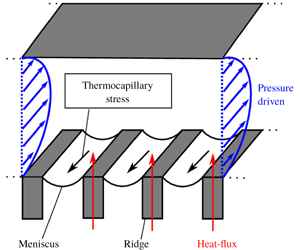Article contents
Thermocapillary stress and meniscus curvature effects on slip lengths in ridged microchannels
Published online by Cambridge University Press: 04 May 2020
Abstract

Pressure-driven flow in the presence of heat transfer through a microchannel patterned with parallel ridges is considered. The coupled effects of curvature and thermocapillary stress along the menisci are captured. Streamwise and transverse thermocapillary stresses along menisci cause the flow to be three-dimensional, but when the Reynolds number based on the transverse flow is small the streamwise and transverse flows decouple. In this limit, we solve the streamwise flow problem, i.e. that in the direction parallel to the ridges, using a suite of asymptotic limits and techniques – each previously shown to have wide ranges of validity thereby extending results by Hodes et al. (J. Fluid Mech., vol. 814, 2017, pp. 301–324) for a flat meniscus. First, we take the small-ridge-period limit, and then we account for the curvature of the menisci with two further complementary limits: (i) small meniscus curvature using boundary perturbation; (ii) arbitrary meniscus curvature but for small slip (or cavity) fractions using conformal mapping and the Poisson integral formula. Heating and cooling the liquid always degrade and enhance (apparent) slip, respectively, but their effect is greatest for large meniscus protrusions, with positive protrusion (into the liquid) being the most sensitive. For strong enough heating the solutions become complex, suggesting instability, with large positive protrusions transitioning first.
- Type
- JFM Papers
- Information
- Copyright
- © The Author(s), 2020. Published by Cambridge University Press
References
- 12
- Cited by


